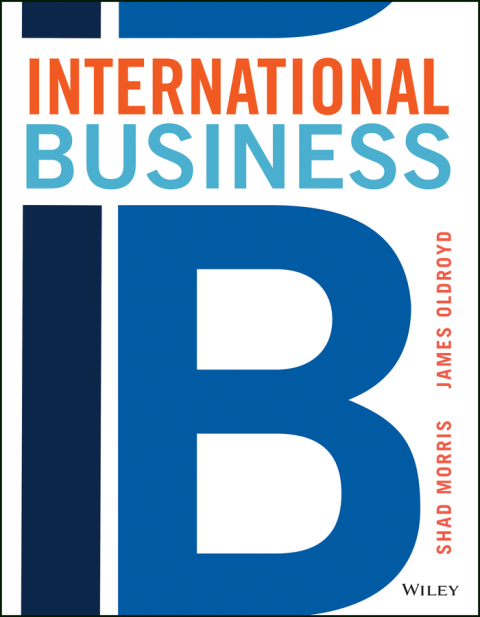Description
Efnisyfirlit
- Cover
- About the Authors
- Preface
- Chapter 1: Globalization
- Introduction
- 1.1 What Is Globalization?
- 1.2 The Flat World, Round World Globalization Debate
- 1.3 Governing Globalization
- 1.4 Managing Globalization
- Summary and Case
- Case: Siri, Where Were You Made?
- Endnotes
- Chapter 2: Analytical Tools for International Business
- Introduction
- 2.1 Why International Business?
- 2.2 External Environment
- 2.3 Internal Environment
- Summary and Case
- Case: Toyota for the World
- Endnotes
- Chapter 3: Political Systems
- Introduction
- 3.1 The Political Spectrum
- 3.2 Political Risks
- 3.3 Measures of Political Freedom
- 3.4 Government’s Involvement in Business
- Summary and Case
- Case Study: Micro Political Risk and the Fast-Food Industry in Korea
- Endnotes
- Chapter 4: The Legal Environment
- Introduction
- 4.1 Differing Legal Systems
- 4.2 Common Legal Issues for International Business
- 4.3 Illegal Versus Unethical Conduct
- 4.4 Important International Laws
- Summary and Case
- Case Study: Can Korean Entertainment Content Companies Compete with Pirates?
- Endnotes
- Chapter 5: Economic Systems
- Introduction
- 5.1 Understanding Economic Systems
- 5.2 Measuring Output
- 5.3 Governmental Economic Controls
- 5.4 Currency Fluctuation and Concentration Effects
- Summary and Case
- Case Study: Comparing GDP Growth in China and India
- Endnotes
- Chapter 6: Currency and Foreign Exchange
- Introduction
- 6.1 What Is Money?
- 6.2 Understanding Exchange Rates
- 6.3 The Consequences of Under- or Overvalued Currencies for International Businesses
- 6.4 Understanding and Managing Exchange Rate Risk
- Summary and Case
- Case Study: BMW and Foreign Exchange Rate Risk
- Endnotes
- Chapter 7: Trade
- Introduction
- 7.1 Theories of Trade
- 7.2 Trade Imbalances and Their Consequences
- 7.3 Patterns of Trade: Increased Regionalization
- 7.4 Government Policies Directed at Trade
- Summary and Case
- Case Study: Globalization and the Fight to Keep 1,000 Carrier Jobs in Indiana
- Endnotes
- Chapter 8: Culture
- Introduction
- 8.1 What Is Culture?
- 8.2 What Does Culture Mean for Business?
- 8.3 Managing Cultural Differences
- 8.4 Building Cultural Intelligence
- Summary and Case
- Case Study: A Cultural Challenge in Managing Ace Adams
- Endnotes
- Chapter 9: Sustainability
- Introduction
- 9.1 What Is Sustainability?
- 9.2 Fighting Short-Termism
- 9.3 Collaborating for Sustainability
- 9.4 Sustainability and Innovation
- Summary and Case
- Case Study: Patagonia Invests in Repair and Recycle
- Endnotes
- Chapter 10: Poverty
- Introduction
- 10.1 Causes and Consequences of Global Poverty
- 10.2 Traditional Responses to Poverty
- 10.3 A Business Response to Poverty
- 10.4 Doing Well and Doing Good
- Summary and Case
- Case Study: Grameen Bank Considers Lending to the Non-Poor
- Endnotes
- Chapter 11: Technological Change and Infrastructure
- Introduction
- 11.1 Technology as Physical Infrastructure
- 11.2 Technology of Information Infrastructure
- 11.3 Technology of Human Infrastructure
- 11.4 Technology Trends in International Business
- Summary and Case
- Case Study: LinkedIn in Brazil
- Endnotes
- Chapter 12: Global Innovation and Intellectual Property
- Introduction
- 12.1 Innovation as a Tool for Global Growth
- 12.2 Investing in Innovation
- 12.3 Driving a Culture of Innovation
- 12.4 Protecting Intellectual Property
- Summary and Case
- Case: Mettler-Toledo: Measuring the Weight of Innovation
- Endnotes
- Chapter 13: Country Selection and Entry Modes
- Introduction
- 13.1 Deciding Which Foreign Markets to Enter
- 13.2 Entry Modes
- 13.3 Make, Ally, or Buy
- Summary and Case
- Case Study: Blendtec Goes Global…Again
- Endnotes
- Chapter 14: International Strategy
- Introduction
- 14.1 What Is Strategy?
- 14.2 Becoming Locally Responsive
- 14.3 Achieving Global Integration
- 14.4 Choosing an International Strategy
- Summary and Case
- Case Study: Lincoln Electric’s International Strategy
- Endnotes
- Chapter 15: International Organizational Structures
- Introduction
- 15.1 Types of Organizational Structures
- 15.2 Informal Organizational Controls
- 15.3 Reducing the Need for Coordination among Subsidiaries: Virtual Organizations, Standards, and Modularity
- 15.4 Horizontal Subsidiary Coordination
- Summary and Case
- Case Study: Control at Zara
- Endnotes
- Chapter 16: Global Leadership
- Introduction
- 16.1 What Is Global Leadership?
- 16.2 Global Leadership Competencies
- 16.3 Building Global Leadership Competencies in Others
- 16.4 Building Global Leadership Competencies in Yourself
- Summary and Case
- Case Study: Honeywell Identifies Future Leadership Needs
- Endnotes
- Chapter 17: Global Marketing
- Introduction
- 17.1 Global Market Segmentation
- 17.2 Standardization Versus Differentiation in International Marketing
- 17.3 Global Branding
- 17.4 Global Pricing and Distribution
- Summary and Case
- Case Study: Peaks Sends Kilimanjaro to Brazil
- Endnotes
- Chapter 18: Global Operations and Supply-Chain Management
- Introduction
- 18.1 Global Procurement
- 18.2 Global Production
- 18.3 Global Supply Chains
- 18.4 Using Data Analytics to Improve Supply Chains
- Summary and Case
- Case Study: Boeing in China
- Endnotes
- Chapter 19: Global Human Resource Management
- Introduction
- 19.1 The Global HR Wheel
- 19.2 Human Capital in the Global Context
- 19.3 Meeting Strategic Objectives Through Human Capital
- 19.4 Tasks of the Global HR Function
- Summary and Case
- Case Study: Intel’s Search for Talent in Vietnam
- Endnotes
- Chapter 20: Global Finance and Accounting
- Introduction
- 20.1 Financing International Trade and Investment
- 20.2 Capital Budgeting for Multinational Companies
- 20.3 International Accounting Standards
- 20.4 Global Tax Matters
- Summary and Case
- Case Study: GlaxoSmithKline: What’s the Right Price to Pay?
- Endnotes
- Glossary
- Index
- End User License Agreement






